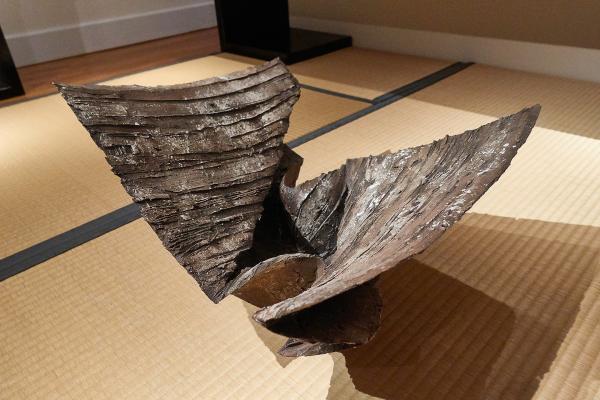While LACMA is temporarily closed to the public, our mission remains to celebrate centuries of creativity and inspiring human endeavors. We’ve asked various members of the museum’s staff to share which favorite LACMA artworks—from ancient to modern, from East to West, from world-renowned to more obscure—they would love to have in their homes during this time.
Existential thoughts arise in our new reality as our quotidian life of the past has shifted, then shifted again. Some artworks help us look inward to meditate on our own reactions, recognize the present unbalance, and look to emerging life in the future. Two recently donated contemporary Japanese ceramics inspire me to imaginarily lay them on my table at home, and take time to contemplate their messages.
The first is called Flake by Izumita Yukiya, who lives on the northeastern coast of Japan, the area that sustained a direct hit during the Great East Japan Earthquake and tsunami of March 11, 2011. Although his studio was repairable, the disaster decimated his village. Izumita has transferred his trauma from that experience and reactions to the vicissitudes of life on that blustery coastline to the forms and surfaces of his works. Using clay mixed with sand from the beach outside his studio, Izumita fashions his thinly potted shapes by supporting thin clay layers with tough, long-fibered Japanese paper (washi). The paper burns away in the kiln. Flake is more sculpture than functional object and is unbalanced, teetering on an uneven base. The broad clay sides strain upward like an unfolding origami crane. The roughly striated surface evokes the sandstone outcroppings that protect Izumita’s studio from the worst of the winter’s snow and wind. Gordon Brodfuehrer, the donor of both artworks mentioned in this blog, likens Izumita’s output in this vein to tectonic plates—in constant tension beneath us.
.jpg)
Seven hundred miles to the southwest, in Kyoto, ceramist and sculptor Hashimoto Machiko employs the color blue as her emblem for life and the passage of time. This work, also non-functional, bears the title Season: Looking Above. Hashimoto sees water and sky as being carriers of life, sustainers of life, and vehicles for conveying the continuance of time. From our frame of reference, the seas and the skies have always been there. Her forms in this series capture the energy of blossoms or seedpods that have exploded into bloom or scattered their contents. This pod appears to have opened with such force that it is collapsing upon itself.
Hashimoto, like Izumita with his use of Japanese paper, is an innovator. She uses only semi-porcelain to pot, which in this piece creates a bright white that sets off the richness of her cobalt oxide (gosu) glaze. I have become stuck in time when staring at this brilliant object, reveling in the oceanic quality of Hashimoto’s blue tones. Sharply carved spines are quite fragile, and to Hashimoto suggest ephemerality within a soft, plant-like object that by its nature is illustrative of the seasons and cycles of life. These ceramics, so rich in content, will remain with me at home, in my mind.



